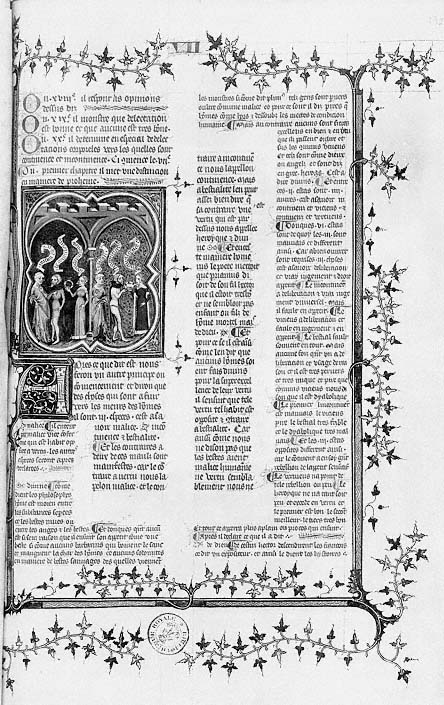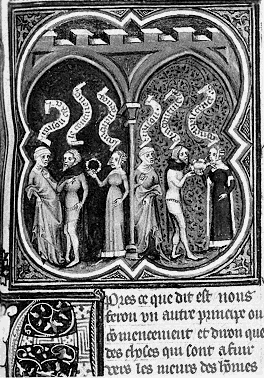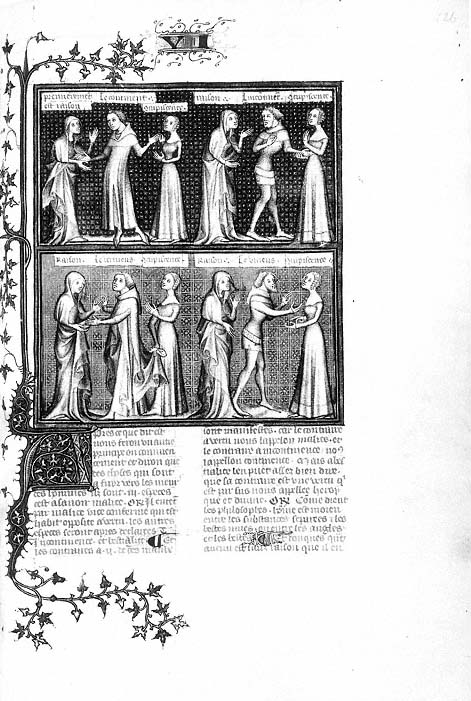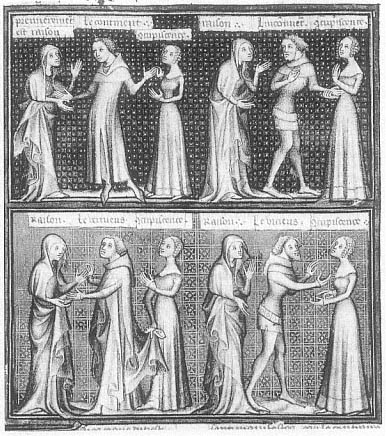11—
Reason and Desire:
Moral Decisions (Book VII)
The Decision Allegory
The illustrations accompanying Book VII in A and C offer the first examples within the cycles of the representational mode of the decision allegory (Figs. 35, 35a and 36, 36a). Panofsky, who coins the term in his essay "Hercules Prodicius," defines the situation as the response of a central protagonist faced with a moral conflict. As was noted in Chapter 4, Panofsky emphasizes the unique character in medieval art of the representations in A and C as decision allegories based not on divine intervention but solely on an individual's voluntary action.[1]
The decision allegory, which occurs for a second time in the illustration of Book IX in C (Fig. 41), overlaps other representational modes in the A and C cycles. Personifications, as abstractions of good and evil forces or of psychological states, interact in ways similar to the personification allegories of Books II and V (Figs. 11, 12, 24, and 29). In these earlier examples the initiator of an action represents a transcendental spiritual force. In contrast, the protagonists in the illustrations of Book VII are distinctly mundane. Figures 35 and 36 also serve their customary function as subject guides to the contents of the book.
Why do the principal subjects of Book VII call for such a distinctive mode of illustration? In one sense, Aristotle continues his discussion from the preceding book of how a variety of intellectual virtues brings about morally positive or negative actions in human life. But Aristotle's focus in Book VII is not so much the rare, ideally virtuous man (or his entirely "vicious" opposite) but the more common human plight of exhibiting moral strength or weakness as reactions to the essential conflict between intellect and desire. The Greek terms for these concepts, Enkrateia and Akrasia , have a complex history in Greek and subsequent philosophy. Because of present-day medical usage, the customary translation of these terms as "continence" (Enkrateia ) and "incontinence" (Akrasia ) both in English and French is unfortunate.[2] In the Middle Ages, however, "continence" and "incontinence" referred to sexual chastity or the lack of it.[3] Moreover, Aristotle does not consider continence and incontinence virtues in themselves. Unlike a person who possesses the virtue of temperance or moderation without conflicts regarding sensory pleasures, the continent or morally strong person has a passionate nature, which he controls only after experiencing a struggle through which the voice of reason guides him.

Figure 35
From left: Raison, Le Continent, Concupiscence; Raison, L'Incontinent,
Concupiscence. Les éthiques d'Aristote, MS A.

Figure 35A
Detail of Fig. 35
Le Continent and L'Incontinent in A
Because of the complex meanings of the terms, Oresme defines both continent and incontinent in his glossary of difficult words. The translator takes great pains to emphasize the Aristotelian meaning of the words and to distinguish them from contemporary Christian usage:
CONTINENT. Celui est continent qui a mauvaises affeccions et temptacions par concupiscence a gloutonnie ou a luxure. Et avecques ce, il a bon jugement de raison, lequel il ensuit, et par ce il refraint ses mauvais desirriers. Et ce fu dit ou .xxi.e chapitre du premier en glose et appert plus a plain ou procés du .vii.e livre. Et si comme il fu dit en l'onzieme chapitre du .ix.e , il est dit continent pour ce que il se tient avecques raison et entendement. Car par ce il se tient avecques soy meïsmes; car chascun est principalment son ame intellective ou son entendement, si comme il fu dit ou quint et en le .xi.e chapitre du .ix.e et ou .xiiii.e chapitre du .x.e .
(CONTINENT. The continent man is one who through concupiscence is subject to bad desires for and temptations to gluttony or lechery. And at the same time he has good rational judgment, which he follows and by which he restrains his bad desires. And this was stated in the twenty-first chapter of the first book in a gloss and
is more fully discussed in the course of the seventh book. And as it was stated in the eleventh chapter of the ninth book, he is called continent because he conducts himself with reason and understanding. For by these means he restrains himself, for the intellective soul or understanding is the basic element of each of us, as was stated in the fifth and eleventh chapters of the ninth book and in the fourteenth chapter of the fifth book.)[4]
Oresme remains faithful to the text in including gluttony with sexual passions as temptations that the continent person can avoid by using good judgment founded on reason. In contrast, the incontinent man, subject to the same desires as his opposite number and holding "vrais principes morals" (true moral principles) and "bon jugement et raison" (good judgment and reason), is unable to resist these temptations. Instead, L'Incontinent is "vaincu et seürmonté par concupiscence, et delaisse raison et ensuit ses desiriers" (vanquished and overcome by concupiscence and abandons reason and follows his desires).[5]
Oresme's efforts to make clear the Aristotelian meanings of Continence and Incontinence in the glossary continue in other locations within the text and glosses. The summary title for Book VII introduces the words and offers a brief explanation of them: "Et aprés commence le .vii.e qui determine de continence, laquelle est une disposicion a vertu; et de incontinence, sa contraire; et de delectacion" (And here begins the seventh book, which examines Continence, which is a disposition toward virtue; and Incontinence, its opposite, and of pleasure).[6] The titles repeat the terms in thirteen of the twenty chapters that follow. Moreover, Oresme's commentary explaining not only the difference between the continent and incontinent persons but also two other states of virtues and vices appears on the same folio as the illustration. Thus, Oresme incorporates a variety of verbal definitions of Continence and Incontinence to which the reader can refer. The inscriptions provide clues for the translator's selection of the main concepts. The term Le Continent identifies the central figure in the left half of the illustration; L'Incontinent occupies the same position on the right. Once again, the inscriptions combine lexical and indexical functions.
Figure 35 is embedded in the first text column following the chapter headings and is placed above the introductory paragraph signaled by the six-line dentellated and foliated initial A . Although the position and dimensions of Figure 35 do not indicate importance within the cycle, the illustration has a unique feature. The miniature is divided into two vertical halves based on the contrast of the opposing characters of Le Continent and L'Incontinent. Previously, lateral division of the picture space in the illustrations of Books III, IV, and VI (Figs. 15, 20, and 33) correspond to identification and explanation of two separate subjects. This new ordering of the picture space by Oresme thus corresponds to the verbal definitions and contrasts he established in the glossary and commentary. Furthermore, the opposition between Continence and Incontinence is immediately set up in the first two paragraphs of the text, directly below and next to the miniature. As noted above, in his commentary Oresme further explains the essential distinctions
between Continence and Incontinence. There the reader also finds the relationships of these states to virtues and vices of different degrees. Even the contrasts of colors in the backgrounds and costumes of the figures carry out the theme of opposition and internal conflict set forth so emphatically in the text and commentary. To bring out these differences, the memory gateway places the opposing characters in separate but adjoining spaces divided by the central column.
The compositions, costumes, and gestures further clarify the contrasting choices made by Le Continent and L'Incontinent. Another way of putting the reader in the picture is Oresme's transformation of the adjectives Continent and Incontinent into nouns.[7] Le Continent and L'Incontinent become masculine equivalents, or concrete exemplars, of types of behavior analyzed by Aristotle. These physical doubles and opposites are identified by inscriptions unfurling vertically over their heads. Their short, tightly fitting jackets, low-slung belts, pointed shoes (poulains ), and colored hoods with trailing ends (liripipes ) distinguish them as fashionable, secular types. Both occupy the center of the shallow picture stage that avoids a strict axial or symmetrical organization. Instead, a more fluid composition pairs Le Continent with the figure on the left. The inscription identifies this personification: "Raison est ce" (this is Reason). Her widowlike headdress and ample blue robe resemble those of virtues like Actrempance and Liberalité (Figs. 15 and 20). Raison also occupies the same position in the right half of the miniature. The third figure, common to both scenes, stands on the right. Her inscription identifies her as Concupiscence (Sexual Desire). Her worldly status as a young woman of fashion is established by her braided tresses and fur-trimmed low-cut gown. In both scenes she proffers a chaplet of flowers, emblem of sensual pleasures.
The decision taken by Le Continent and L'Incontinent toward or away from the two types of conduct is expressed by the movement of their figures. Le Continent has literally turned his back on Concupiscence. His proximity to Raison, reinforced by his glance, the touch of his arm, and the position of his right foot emphasizes that he listens to her counsel. Yet, Le Continent indicates a struggle with his passions by pointing toward the eager and expectant figure of Concupiscence. A sense of uncertainty or anxiety about the outcome derives also from the expression of Raison's face and the tense gestures of her upraised and rigid hands. But the void between Le Continent and Concupiscence confirms the nature of his decision. The opposite conclusion takes place in the right half of the miniature, where L'Incontinent turns his back on Raison and moves in the direction of Concupiscence. Not only do his feet advance toward her, but he touches her shoulder with his outstretched left arm and with his other reaches for the wreath of flowers. Raison's resigned expression and upraised hand acknowledge that L'Incontinent has taken a step in the wrong direction. The vivid body language, expressed in visual metaphors such as "turning his back" or "taking a step in the right direction," reinforces the verbal language of the inscriptions.
The decision allegory in A is marked by a concrete and specific action taken by a contemporary secular figure. The visual evidence of moral struggle based on the protagonist's conflict between Reason and Desire is effectively conveyed. Whereas Aristotle did not single out sexual pleasure as the only area of moral

Figure 36
Above, from left : Raison, Le Continent, Concupiscence; Raison, L'Incontinent,
Concupiscence; below, from left : Raison, Le Vertueus, Concupiscence; Raison,
Le Vicieus, Concupiscence. Les éthiques d'Aristote, MS C.

Figure 36A
Detail of Fig. 36
conflict, Oresme may have chosen to do so because of the traditional medieval associations of the term Continence . Nevertheless, thanks to the fluent style of the Jean de Sy Master, the illustration makes clear the essence of the verbal definition. Oresme's instructions probably specified details of costume, gesture, and identity of the opposing protagonists. Such a program is an ingenious solution to the visual and verbal translations of subtle philosophical concepts clearly conveyed to Oresme's secular audience. Rooted in rhetorical strategies, complex visual devices such as repetition, opposition, and single versus double identities are designed to engage and enhance the cognitive and mnemonic responses of these readers.
The Expanded Decision Allegory of C
The decision allegory illustrating Book VII in C (Figs. 36 and 36a) keeps the basic scheme established in A but adds a second register that expands and shifts the scope of meaning. Consistent with Oresme's editorial revision of the program in C and the physical changes noted in the second half of the book, the illustration
has grown larger. Figure 36 is almost twice the height of the miniature introducing Book V (Fig. 29). Moreover, in the decision allegory of C , the figures dominate the image. Except for the rectangular inscriptions placed at the top of each scene, there is no setting analogous to the crenellated wall or tricolor inner frame of Figure 35. Indeed, the lack of any internal division (such as a line) makes it difficult at first to understand the contrasts between what constitute two separate scenes on the left and right of each register. The situation is slightly clearer in the lower register, since a double vertical line belonging to the background motif serves to separate the two halves of the scene. This lack of demarcation may have resulted from the miniaturist's misunderstanding of Oresme's new or revised instructions. Placed at the top of the folio following the chapter headings on the previous leaf, Figure 36 seems very much more a frontispiece illustration than Figure 35, which is located nine lines below the top of the first column. The grisaille figures of Figure 36 stand out sharply against the deep blue geometric background of the top register and the contrasting apricot and gold tones of the lower one.
Certain minor but significant changes are noticeable in the top zone of Figure 36. For one thing, instead of the inscription "Raison est ce" on the left of Figure 35, the phrase in Figure 36 reads "premièrement est raison" (first comes reason). The word premièrement suggests that Le Continent has as his first resource deliberation and use of reason. Omitted from the top register is the wreath of flowers held by Concupiscence in Figure 35. Such a decision is consonant with a rejection in the C cycle of visual emblems. Instead, an increased reliance on hand gestures signifies tension or conflict among the figures. Indeed, the awkwardly shaped hands, as well as the outsized feet and elongated proportions of both women and men, are hallmarks of the workshop of the Master of the Coronation of Charles VI. Also different in the top left scene of Figure 36 is the compositional relationship among the figures. Le Continent stands almost equidistant from the two females, while with outstretched hands he touches both of them. Although, as in Figure 35, Le Continent again turns his back on Concupiscence and looks at Raison, the play of hands suggests a continuing struggle to choose between the female forces. A similar indecision of the male protagonist is apparent in the upper right scene. Here ambivalence is conveyed by the manner in which L'Incontinent glances toward Raison while still turning his back on her. He seems to be listening to Raison's exhortations, suggested by the forward tilt of her head and the pleading gestures of her hands. An important change from Figure 35 noted by Panofsky is the difference in dress between Le Continent and L'Incontinent.[8] In Figure 36 the former wears a plain, full-length mantle associated with a cleric or scholar, while the latter retains the contemporary, fashionable dress worn in Figure 35 by both figures. In other words, instead of the more subtle concept of likeness between the two types of conduct established in Figure 35, the analogous scenes of C introduce a social and moral dichotomy.
The left and right scenes of the lower zone repeat the same contrast between the behavior and status of the male figures. Le Vertueus (the virtuous man), personalized in a similar way to his analogue Le Continent, contrasts with Le Vicieus (the man given to vice), the counterpart of L'Incontinent. The two female figures,
however, remain the same as on the upper register. What is the rationale for this second level of the decision allegory? First, the explicit, didactic character of the entire program of C surely figures in the expansion. Second, Oresme may have responded to questions about the relationships among Continence and Vertu and their opposites as points of philosophical debate. Addition of a second level also permits clarification of Aristotle's distinctions between degrees or states of moral behavior. A textual basis for such clarification is provided by Oresme in his lengthy commentary in C (fol. 132) cited above as the basis for his definitions of Continence and L'Incontinence. A relevant passage reads:
Et entre ces .ii. estas sont .iiii. autres; c'est a savoir, incontinenz et vicieus et continenz et vertueus. Donques .vi. estas sont de quoy les .iii. sont mauvais et different ainsi. Car a bien ouvrer sont requises .iii. choses; c'est a savoir, deliberacion et vray jugement et droit appetit. Le incontinent a deliberacion et vrai jugement universel, mais il fault an appetit. Le vicieus a deliberacion et fault en jugement et en appetit.
(And between these two states are four others, to wit, incontinent and given to vice and continent and given to virtue. So there are six states, of which three are bad and differ as follows. For to act well three things are required: to wit, deliberation, true judgment, and right appetite. The incontinent man has deliberation and true judgment overall, but he fails with regard to appetite. The man given to vice has deliberation and fails with regard to judgment and appetite.)[9]
Both verbal and visual links help the reader to associate on two levels similar and contrasting moral types. Visually, parallel placement and repetition of costume help the reader to forge the connections between the figures in the left halves of Figure 36, Le Continent above and Le Vertueus below, and on the right, L'Incontinent and Le Vicieus. Of course, on two levels, the opposition also continues between the morally strong and weak types depicted on the left and right. The reader's reference to the first sentence of Oresme's commentary, cited above, explains the basis of such pairing. For example, the figure of Le Vertueus meets the three requirements listed: deliberation, true judgment, and right desire. He has turned his whole body and stepped toward Raison, who welcomes him with outstretched hands. His back is turned away from Concupiscence, who vainly tugs at his mantle. Two further passages from the same commentary elucidate the contrast. A gentle expression and contained stance confirm that "Le vertueus n'a point de tele rebellion ou peu" (The virtuous man possesses little or no such rebellion within him). Such resoluteness contrasts with Le Continent, who "a en soy grant rebellion de l'appetit sensitif" (who is capable of resisting his appetite for sensual pleasures). Following the opposite track, Le Vicieus, who lacks judgment and desire to do right, opts for Concupiscence by stepping toward her with arms outstretched and turning his back on Raison. Le Vicieus no longer even listens to Raison, as does L'Incontinent in the zone above him. In short, the scenes of the upper register convey the sense of moral struggle and temporary, tentative choices, while those below depict decisive and habitual modes of conduct.[10] Moreover, the
repeated difference in costume between the two types of character in the lower register suggests that the continent and virtuous modes of life are practiced by scholars or clerics, whereas those who exemplify moral weakness and wicked indulgence in bodily pleasures inhabit a fashionable, secular world.
The Embodiment of Moral Dilemmas
At first glance, the miniature for Book VII in A (Figs. 35 and 35a) is modest, unremarkable for either size or position on the folio. But the illustration has considerable importance as a decision allegory. The illuminator successfully employs body language as visual metaphors for actions and choices made by an individual. In this first instance of the decision allegory, position in the center of the picture field expresses another aspect of the Aristotelian concept of the mean in which man occupies a moral position between the angelic and the bestial. The central position also embodies the dilemma faced by the man in the middle, pressed by conflicting moral choices. The preference for a triadic ordering scheme is consistent with Aristotle's advice that it is easier to recollect a central idea by relating it to concepts on either side of it.
Consistent with the pattern established in the cycle, the spiritual forces are represented as feminine, while the main protagonists are male. In Figure 35, Concupiscence is the sole depiction in the cycle of A of a negative feminine force, although in C , similar representations of vices appear in the illustrations of Books III and IV (Figs. 16 and 21). In both Figures 35 and 36, however, as in Figure 24b, the distance between the spiritual and "real" worlds is obscured by naturalistic scale, contemporary costumes, and shared gestures and expressions. Such a veristic approach, only partially related to style, gives particularly to the male figures the character of concrete, human exemplars rather than the more general personifications of abstract ideas.[11] Fashionable contemporary dress especially emphasizes the exemplary nature of Le Continent, L'Incontinent, and Concupiscence and distinguishes them from the sexually neutral Raison.
The illustration in C (Fig. 36) differs from that of Figure 35 because of the wider contrasts of moral states established in the lower register of C . It is also possible that the illustration in A offered too subtle a contrast between Le Continent and L'Incontinent, whose similarity of appearance suggests too great an identity of character. Again, Oresme may have responded to his own or the king's criticism, when in Figure 36 he differentiates by their costume the morally strong Le Continent and Le Vertueus from the weak-willed L'Incontinent and Le Vicieus. Oresme may also have intended that the social identification of the ethically strong with the intellectual and scholarly university élite serve as a warning to Charles V's worldly courtiers. Oresme may also have enjoyed the opportunity to explicate these ideas orally to Charles V and his circle. Such an occasion would have allowed him to expand on previous warnings about prodigality and unwise expenditure, particularly those expressed in the illustration of Book IV in C (Fig. 21). Oresme may have welcomed the opportunity to voice the views of a clerical moralist addressing his secular court audience.